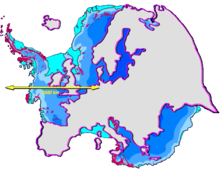Antarctica
Antarctica (pronounced
/ænˈtɑrktɪkə/ ( listen)
listen)) is
Earth's southernmost
continent, encapsulating the
South Pole. It is situated in the
Antarctic region of the
southern hemisphere, almost entirely south of the
Antarctic Circle, and is surrounded by the
Southern Ocean. At 14.0 million km
2 (5.4 million sq mi), it is the fifth-largest continent in area after
Asia,
Africa,
North America, and
South America. About 98% of Antarctica is covered by
ice that averages at least 1.6 kilometres (1.0 mi) in thickness.
Antarctica, on average, is the coldest, driest, and windiest continent, and has the highest average
elevation of all the continents.
[2] Antarctica is considered a
desert, with annual precipitation of only 200 mm (8 inches) along the coast and far less inland.
[3] There are no permanent human residents, but anywhere from 1,000 to 5,000 people reside throughout the year at the research stations scattered across the continent. Only cold-adapted plants and animals survive there, including
penguins,
seals,
nematodes,
tardigrades,
mites, many types of
algae and other microorganisms, and
tundra vegetation.
Although myths and speculation about a
Terra Australis ("Southern Land") date back to antiquity, the first confirmed sighting of the continent is commonly accepted to have occurred in 1820 by the Russian expedition of
Fabian Gottlieb von Bellingshausen and
Mikhail Lazarev. The continent, however, remained largely neglected for the rest of the 19th century because of its hostile environment, lack of resources, and isolation. The
Antarctic Treaty was signed in 1959 by 12 countries; to date, 46 countries have signed the treaty. The treaty prohibits military activities and mineral mining, supports scientific research, and protects the continent's
ecozone. Ongoing experiments are conducted by more than 4,000 scientists of many nationalities and with various research interests.
[1]
The first formal use of the name "Antarctica" as a continental name in the 1890s is attributed to the Scottish
cartographer John George Bartholomew. The name
Antarctica is the
romanized version of the
Greek compound word
ἀνταρκτική (
antarktiké), feminine of
ἀνταρκτικός (
antarktikos),
[4] meaning "opposite to the
Arctic", "opposite to the north".
[5]
Geography

West Antarctica on the left.

Elevation colored by relief height

Size comparison Europe-Antarctica
Centered asymmetrically around the
South Pole and largely south of the Antarctic Circle, Antarctica is the southernmost continent and is surrounded by the
Southern Ocean; alternatively, it may be considered to be surrounded by the southern
Pacific,
Atlantic, and Indian Oceans, or by the southern waters of the
World Ocean. It covers more than 14,000,000 km
2 (5,400,000 sq mi), making it the fifth-largest continent, about 1.3 times as large as Europe. The coastline measures 17,968 km (11,165 mi) and is mostly characterized by ice formations, as the following table shows:



